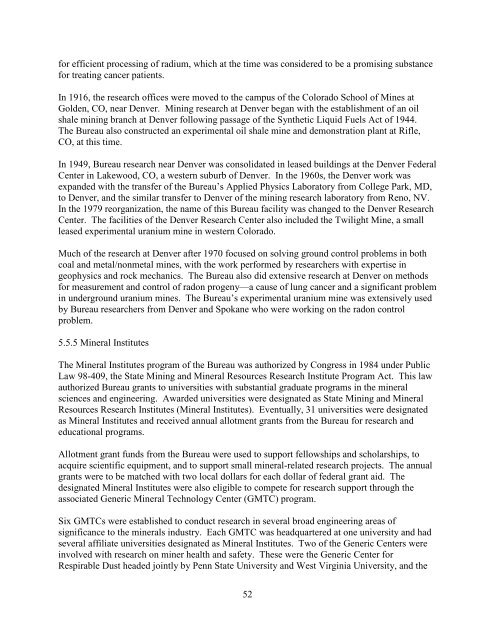One Hundred Years of Federal Mining Safety and Health Research
One Hundred Years of Federal Mining Safety and Health Research
One Hundred Years of Federal Mining Safety and Health Research
- No tags were found...
You also want an ePaper? Increase the reach of your titles
YUMPU automatically turns print PDFs into web optimized ePapers that Google loves.
for efficient processing <strong>of</strong> radium, which at the time was considered to be a promising substance<br />
for treating cancer patients.<br />
In 1916, the research <strong>of</strong>fices were moved to the campus <strong>of</strong> the Colorado School <strong>of</strong> Mines at<br />
Golden, CO, near Denver. <strong>Mining</strong> research at Denver began with the establishment <strong>of</strong> an oil<br />
shale mining branch at Denver following passage <strong>of</strong> the Synthetic Liquid Fuels Act <strong>of</strong> 1944.<br />
The Bureau also constructed an experimental oil shale mine <strong>and</strong> demonstration plant at Rifle,<br />
CO, at this time.<br />
In 1949, Bureau research near Denver was consolidated in leased buildings at the Denver <strong>Federal</strong><br />
Center in Lakewood, CO, a western suburb <strong>of</strong> Denver. In the 1960s, the Denver work was<br />
exp<strong>and</strong>ed with the transfer <strong>of</strong> the Bureau’s Applied Physics Laboratory from College Park, MD,<br />
to Denver, <strong>and</strong> the similar transfer to Denver <strong>of</strong> the mining research laboratory from Reno, NV.<br />
In the 1979 reorganization, the name <strong>of</strong> this Bureau facility was changed to the Denver <strong>Research</strong><br />
Center. The facilities <strong>of</strong> the Denver <strong>Research</strong> Center also included the Twilight Mine, a small<br />
leased experimental uranium mine in western Colorado.<br />
Much <strong>of</strong> the research at Denver after 1970 focused on solving ground control problems in both<br />
coal <strong>and</strong> metal/nonmetal mines, with the work performed by researchers with expertise in<br />
geophysics <strong>and</strong> rock mechanics. The Bureau also did extensive research at Denver on methods<br />
for measurement <strong>and</strong> control <strong>of</strong> radon progeny—a cause <strong>of</strong> lung cancer <strong>and</strong> a significant problem<br />
in underground uranium mines. The Bureau’s experimental uranium mine was extensively used<br />
by Bureau researchers from Denver <strong>and</strong> Spokane who were working on the radon control<br />
problem.<br />
5.5.5 Mineral Institutes<br />
The Mineral Institutes program <strong>of</strong> the Bureau was authorized by Congress in 1984 under Public<br />
Law 98-409, the State <strong>Mining</strong> <strong>and</strong> Mineral Resources <strong>Research</strong> Institute Program Act. This law<br />
authorized Bureau grants to universities with substantial graduate programs in the mineral<br />
sciences <strong>and</strong> engineering. Awarded universities were designated as State <strong>Mining</strong> <strong>and</strong> Mineral<br />
Resources <strong>Research</strong> Institutes (Mineral Institutes). Eventually, 31 universities were designated<br />
as Mineral Institutes <strong>and</strong> received annual allotment grants from the Bureau for research <strong>and</strong><br />
educational programs.<br />
Allotment grant funds from the Bureau were used to support fellowships <strong>and</strong> scholarships, to<br />
acquire scientific equipment, <strong>and</strong> to support small mineral-related research projects. The annual<br />
grants were to be matched with two local dollars for each dollar <strong>of</strong> federal grant aid. The<br />
designated Mineral Institutes were also eligible to compete for research support through the<br />
associated Generic Mineral Technology Center (GMTC) program.<br />
Six GMTCs were established to conduct research in several broad engineering areas <strong>of</strong><br />
significance to the minerals industry. Each GMTC was headquartered at one university <strong>and</strong> had<br />
several affiliate universities designated as Mineral Institutes. Two <strong>of</strong> the Generic Centers were<br />
involved with research on miner health <strong>and</strong> safety. These were the Generic Center for<br />
Respirable Dust headed jointly by Penn State University <strong>and</strong> West Virginia University, <strong>and</strong> the<br />
52
















